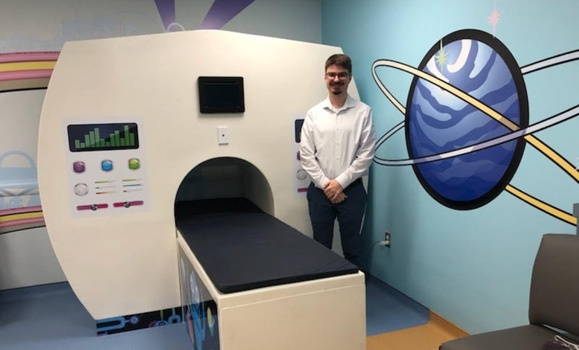Going to the hospital can be a terrifying experience for anyone, but it can be especially scary for children. Magnetic resonance imaging machines, or MRIs, are no exception, often provoking extreme anxiety with their unfamiliar sounds and confined space.
A new MRI simulator at the IWK Health Centre designed by recent Dal engineering grads may help change that.
While in the process of acquiring a new MRI, the IWK Health Centre reached out to the Faculty of Engineering and proposed a project: engineering students would create a simulator that replicates the experience of being in an MRI.
Concept to reality
Jonathon Betteridge, who graduated with a degree in mechanical engineering in May 2020, worked on the simulator as part of his final year capstone project last year. He, along with his classmates Michael Smith, Daniel Monk, and Ben Parmiter, spent several months designing and building the simulator.
“We designed the whole thing throughout the course of September to December and then come January we actually started building it,” he said. “Then we had to redesign a couple things as we started building because we realized ‘oh that didn't quite work as well as we'd hoped.’”
After the COVID-19 pandemic shut down work on the project last spring the simulator was on hold for several months. Betteridge was able to come back in September 2020 and finish the project with the help of Dalhousie employees.
“We are very delighted with the outcome and know many of our patients will benefit from it,” said Dr. Naeem Khan, chief of the Department of Radiology at the IWK Health Centre, in a press release.
A positive impact
The simulator is outfitted with various features to make it feel as real as possible. The Dal students even designed an app that can play different noises the MRI machine makes while in use.
The goal, according to Betteridge, is that the simulator will lead to children being more comfortable with the MRI machine, and ultimately the use of less sedatives.
Now, the simulator is located in the MRI waiting room and Betteridge says it’s accessible to patients. While at the IWK, he spoke to parents who were pleased to see the simulator and believed it would make a positive impact on the experience of children in the hospital.
That positive impact is what drew Betteridge to the project. He, along with his fellow students, were given different a choice of different project options for their capstone project.
“It was one of the projects that seemed like it would actually be able to make an immediate impact on the community,” he said.
While there’s no denying a trip to the hospital can be nerve-wracking, the MRI simulator will hopefully make it a little easier.

